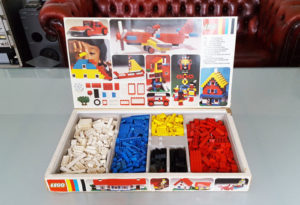
In a day and age when many of our favorite childhood toys have ridden off into the sunset, either victims of hard financial times, or perhaps, like Kenner, were bought and sold into total obscurity, it’s refreshing to see a treasured childhood memory doing very well, thank you.
Such is the case with today’s subject, Lego.
I remember Legos being a hot new item in the 60’s. But in researching this piece, I was quite surprised to learn that its history is as venerable as that of Lincoln Logs and Tinkertoys, going all the way back to early in the 20th century.
It all started with a Danish gentleman by the name of Ole Kirk Christiansen. He was in the business of producing buildings and furniture for the locals when, in 1924, his two young sons set a fire while playing with some wood shavings which destroyed Ole’s workshop.
Ole took it in stride, and looked at the disaster as an opportunity to build a new workshop with greater capabilities. Thus, he began producing miniaturized versions of his furniture and buildings to be used as aids in designing.
At this point, the history gets a bit fuzzy. But the prevailing opinion seems to be that Ole’s carpentry business went downhill, and it was suggested by friends and associates that he spend his time making miniaturized toys instead.
By 1932, he was doing just that. He was barely surviving the Depression, often trading toys and the occasional furniture for food. In 1934, Ole held a contest among his few employees to give his new toy company a name. The prize was a bottle of homemade wine. The winner was Lego, which, in Danish, meant “play well.” It was a further bonus that in Latin it was translated “I put together” or “I assemble.”
The company held on, surviving Nazi occupation of Denmark, and another catastrophic fire, this one in 1942. By the late 40’s, Lego had begin experimenting with plastics. Plastics were pretty primitive back then, but Ole and his son Godtfred saw potential for it.
In 1947, Ole and his son obtained some plastic interlocking bricks made by a company named Kiddicraft. They were impressed with the concept, and sought to build an improved version, with pegs on the top of the brick interlocking with the hollow bottom. In 1953, they released the first recognizable Lego bricks to the European world.
Plastic was by and large considered cheap junk, particularly by the European shopping community, so sales weren’t that great. But soon Godtfred spoke with some international buyers who suggested he expand his vision to include an entire construction system, complete with things like roofs, windows, doors, and perhaps even people.

But first, the blocks needed improved engineering. In 1958, hollow cylinders were added to the bottom of the brick, which made for stronger interlocking. The Lego brick was ready to explode upon a world of Boomer children.
Yet another major fire destroyed practically all of Lego’s wooden toy stock in 1960, so Godtfred (by now Ole had died) decided to commit the company to the manufacture of plastic building systems. It was a good call.
Lego toys were a smash hit in Europe, and the company cut deals to begin selling them in the US and Canada in 1962. They took the countries by storm, and the company sailed high. The bricks continued to be improved with better quality plastics, and more and more designs were offered. Kids were building Lego cars, airplanes, ships, skyscrapers, the limits being only their imaginations. Instruction sheets were added to kits in the mid 60’s, but many kids freelanced creations even more wonderful than the suggested ones.
In 1968, the Danish version of Disneyland was built in Billund, home of Lego. Legoland eventually grew to a million visitors a year. There are now four Legoland theme parks and five learning centers found all over the world.
And the Lego company has withstood hard financial times, a Nazi invasion, and several catastrophic fires to be one of the most successful toys ever made. Their corporate website lists them as number five in the world, not bad for a little Danish company that survived the Depression by trading toys for food. And best of all, they remain a private company. Being privately owned provides a stability not available with publicly-owned counterparts. I work full time for a private company which has never had a layoff in its long history.
Lego’s future looks good, too. In 2009, a Lego movie was announced, to be filmed as part animation and part live action. The company produces themed toy sets for popular movies with nearly every release. And the best news is that our grandchildren play with Lego sets that are very much like the ones we had, only with more cool stuff that we could only dream about.
I intentionally left out my own memories here because, believe it or not, I never had Legos, although I did play with them over at a buddy’s house. So what are your own Lego memories?